Restriction Endonuclease Enzyme Example
Restriction Endonuclease Enzyme Example. A restriction enzyme recognizes and cuts dna only at a particular sequence of nucleotides. (1) exonucleases catalyses hydrolysis of terminal nucleotides from the end of dna or rna molecule either 5'to 3' direction or 3' to 5' direction.
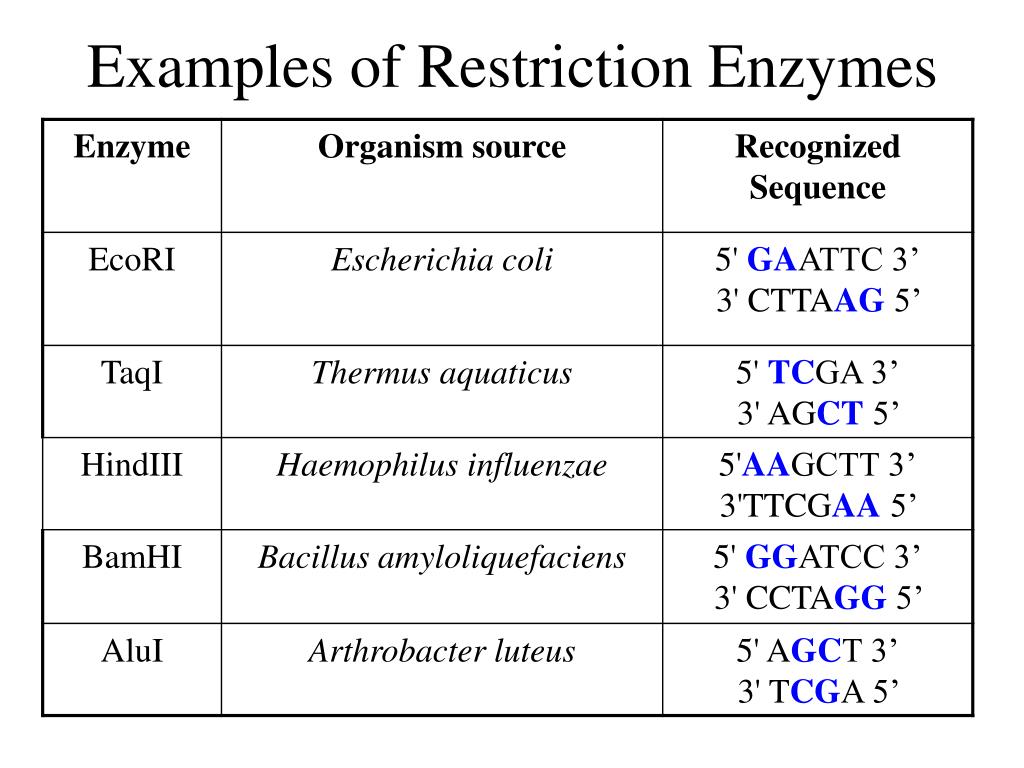
 PPT Restriction Enzymes PowerPoint Presentation, free from www.slideserve.com
PPT Restriction Enzymes PowerPoint Presentation, free from www.slideserve.comTo ensure the bacteria s own genome is not degraded, each restriction endonuclease has a complementa ry methylating enzyme that methylates the restriction endonuclease site on the genomic dna preventing digestion. The restriction enzymes are known as the molecular scissors which can recognize and then cleave the dna at specific restriction sites to produce fragments. However, some produce blunt ends.
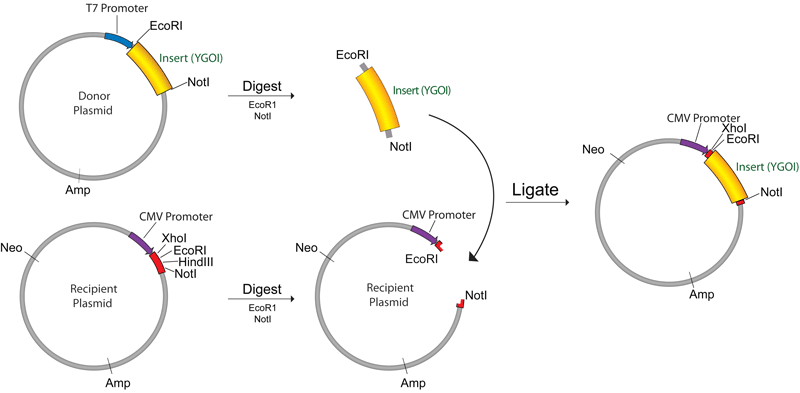
The restriction endonuclease will recognize the restriction sequences,. The products of the reactions were fractionated by polyacrylamide gel electrophoresis, and autoradiography was performed (fig.

Restriction enzyme, also called restriction endonuclease, is a protein produced by bacteria that cleaves dna at specific sites along the molecule. But the site of cleavage is specific for the restriction endonuclease.

A restriction enzyme recognizes and cuts dna only at a particular sequence of nucleotides. & 'x' is the number of restriction enzymes that we have (example 5).
The labeled dna was then incubated in the presence (sample 2 in fig. How to construct a restriction map?

A restriction enzyme recognizes and cuts dna only at a particular sequence of nucleotides. The biological function of type iv restriction systems is to restrict modified foreign dna (phage or plasmid) (35,15).

& take the sample dna in 'x' number of vials. 3 different subunits atp ,mg2+ s adenosyle methionine random,upto 1000 bp away from restriction site.

& 'x' is the number of restriction enzymes that we have (example 5). The combined role of these two enzymes is known as the restriction:modification system.
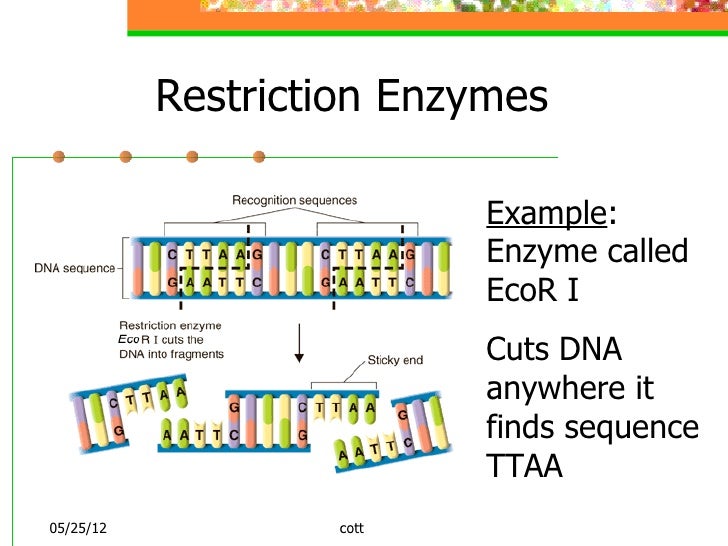
& take the sample dna in 'x' number of vials. However, some produce blunt ends.
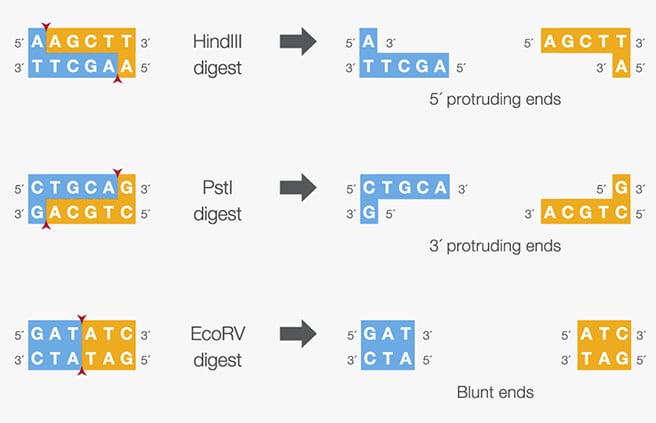
The rarer the site it recognizes, the smaller the number of pieces produced by a given restriction endonuclease. How to construct a restriction map?
For example, the restriction endonuclease ecor i, isolated from the bacterium escherichia coli, recognizes the following sequence: 3 different subunits atp ,mg2+ s adenosyle methionine random,upto 1000 bp away from restriction site.

5 ′ gaattc 3 ′ 3 ′ cttaag 5 ′. The labeled dna was then incubated in the presence (sample 2 in fig.
Restriction endonucleases are enzymes that recognize a specific dna sequence, called a restriction site, and cleave the dna within or adjacent to that site. Neoschizomers are the restriction enzymes which recognize the same site and have a different cleavage pattern.

For example, saci and sacii are derived from streptomyces achromogenes.of. In the dna, there are some specific sequences termed as "recognition or restriction sequences".

The products of the reactions were fractionated by polyacrylamide gel electrophoresis, and autoradiography was performed (fig. A dna segment, digested by a specific restriction enzyme, is cut into smaller dna fragments of different sizes.
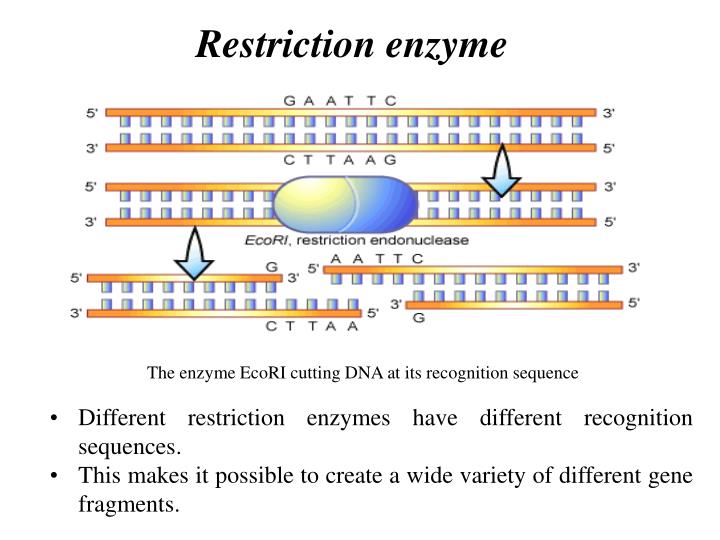
We tested the restriction of phages by sauusi endonuclease using dcm + or dcm − λ phages that have been grown on modification proficient or deficient e. If a particular strain has more than one restriction enzyme, these will be identified by roman numerals as i, ii, iii, etc.

The convention for naming these enzymes is the first letter of the name comes from the genus and the second two letters come from the species of the prokaryotic cell from which they were. Additional diversity was found among the isoschizomers.

Isoschizomers are the restriction enzymes which recognize and cleave at the same recognition site. Most restriction enzyme recognition sequences are from four to eight bases long and most are palindromic (table 1).

The labeled dna was then incubated in the presence (sample 2 in fig. For example, sphi (cgtac/g) and bbui (cgtac/g) are isoschizomers of each other.

& treat the sample dna with the specific restriction enzyme separately. The labeled dna was then incubated in the presence (sample 2 in fig.
Restriction enzyme, also called restriction endonuclease, a protein produced by bacteria that cleaves dna at specific sites along the molecule.in the bacterial cell, restriction enzymes cleave foreign dna, thus eliminating infecting organisms. The restriction endonuclease will recognize the restriction sequences,.
For Example, The Enzyme Eco Ri Was Isolated From The Bacterium Escherichia (E) Coli (Co) Strain Ry13 (R) And It Was The First Endonuclease (I).Isoschizomers are the restriction enzymes which recognize and cleave at the same recognition site. Restriction enzyme, also called restriction endonuclease, a protein produced by bacteria that cleaves dna at specific sites along the molecule.in the bacterial cell, restriction enzymes cleave foreign dna, thus eliminating infecting organisms. (1) exonucleases catalyses hydrolysis of terminal nucleotides from the end of dna or rna molecule either 5'to 3' direction or 3' to 5' direction.
The Restriction Endonuclease Will Recognize The Restriction Sequences,.Additional diversity was found among the isoschizomers. How to construct a restriction map? A restriction enzyme is a type of endonuclease enzyme, which functions to cleave the nucleotide sequences in between the dna strand.
Exonuclease I, Exonuclease Ii Etc.Restriction endonucleases cut the dna double helix in. The biological function of type iv restriction systems is to restrict modified foreign dna (phage or plasmid) (35,15). For example, the restriction endonuclease ecor i, isolated from the bacterium escherichia coli, recognizes the following sequence:
The Chemical Bonds That The Enzymes Cleave Can Be Reformed By Other Enzymes Known As.(2) endonucleases can recognize specific base sequence (restriction site) within dna or rna molecule and cleave internal. & take the sample dna in 'x' number of vials. This enzyme is isolated from the e.
The Restriction Enzymes Are Known As The Molecular Scissors Which Can Recognize And Then Cleave The Dna At Specific Restriction Sites To Produce Fragments.The rarer the site it recognizes, the smaller the number of pieces produced by a given restriction endonuclease. There are two different kinds of restriction enzymes: List of 357 identified restriction enzymes recognizing 90 different dna sequences was published [7].
Belum ada Komentar untuk "Restriction Endonuclease Enzyme Example"
Posting Komentar